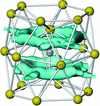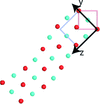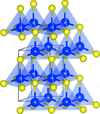issue contents
December 2018 issue
Special issue on mineralogical crystallography
Guest Editors: Sergey V. Krivovichev, Janusz Lipkowski and Stuart J. Mills

Cover illustration: Structure of aravaite consisting of blocks of ariegilatite and stracherite, see Biljana Krüger et al. [(2018). Acta Cryst. B74, 492–501].
mineralogical crystallography
Free 

A priori bond valences and bond lengths are calculated for a series of rock-forming minerals. Comparison of a priori and observed bond lengths allows structural strain to be assessed for those minerals.
Download citation


Download citation


VSH-13Na crystals represent coherent intergrowths of two polytypes (allotwinning) characterized by different orientations of the V=O apical bond in the VO5 pyramids. The dehydration behaviour of this composite structure is presented in comparison with natural vanadosilicates.
Download citation


Download citation


The crystal structure of the new mineral aravaite was solved using synchrotron radiation and its disorder is modelled.
CCDC reference: 1864463
The crystal-chemical characterization of copper minerals (96 oxysalts, chlorides and oxides belonging to 80 structure types) formed in volcanic fumaroles is given, including data on complexes of Cu2+-centred polyhedra in these structures and on cationic and anionic isomorphism. The significant crystal-chemical difference between minerals formed in the hot (>473 K) and moderately hot (323–423 K) zones of fumaroles is shown; all high-temperature minerals are H-free and the Cu2+ cation in them exhibits a strong affinity for four- and fivefold coordination, unlike moderate-temperature fumarolic copper minerals which mainly contain OH and/or H2O and in which Cu2+ shows an affinity for octahedral coordination, as it also does in Cu minerals formed in the oxidation zones of chalcogenide ores.
Polymorphism and structural topology of the copper-bearing minerals of the atacamite family are reviewed in regard to the observed magnetic properties.
The structural behavior of copper and silver in selected natural sulfosalts where these elements play a major role is reviewed.
The discovery of naturally occurring metal–organic framework (MOF) minerals highlights the connection between crystal engineering and mineralogy. It is shown how classification of such organic minerals rests on concepts of supramolecular chemistry, coordination chemistry and crystal engineering.
research papers
Open  access
access
 access
accessThe combinations of phase transitions which occur in Heusler alloys in terms of order parameters and symmetry have been analysed using a group theoretical approach. It is shown how this approach can be applied to relevant examples.
Download citation


Download citation


A detailed quantitative evaluation of the nature, energetics, electrostatic contributions and topological properties of short and directional intermolecular interactions on 23 halogenated benzamides in the solid state has been performed. The occurrence of three-, two- and one-dimensional isostructurality in halogen (Cl, Br, I) substituted benzamides are also investigated.
Download citation


Download citation


The structure of the three-dimensional MOF compound [Eu5(C2H4O2)6(CH3CO2)3]n was solved ab initio from synchrotron X-ray powder diffraction. With pore volumes of 82 Å3, the structure is similar to those usually observed in zeolites, which makes it suitable for gas storage.
CCDC reference: 1867704
Download citation


Download citation


The crystal structures of calcium D-gluconate and calcium α-D-isosaccharinate nave been determined, the latter using a synchrotron source, and found to be coordination polymers. Computational studies complement the structure determinations.
Download citation


Download citation


The σ-hole and π-hole bonding interactions in cocrystals consisting of acenaphthene and haloperfluorobenzenes can be predicted before assembling them by using the maximum surface electrostatic potential difference between the σ-hole and the π-hole in the bonding donor molecules. Thus, fluorescence, delayed fluorescence and phosphorescence properties of the cocrystals can be estimated.
Download citation


Download citation


Supramolecular assemblies of halogenated and hydroxyl hydrazones derived from pharmaceuticals are governed by I⋯N and I⋯π halogen bonds or O—H⋯N hydrogen bonds. An unexpected linear arrangement of clathrated dichloromethane molecules bound through type I and II halogen bonds is observed. Theoretical calculations support the crystallographic study.
The main topic of this study is newly discovered ZnO/ZnS polytypes, which provide alternative structural arrangements of ZnO/ZnS compounds. In particular, pristine ZnO and ZnS compounds and mixed ZnO1–xSx compounds (x = 0.20, 0.25, 0.33, 0.50, 0.60, 0.66 and 0.75) have been investigated. All calculations have been performed at ab initio level using density functional theory–local density approximation and hybrid Heyd–Scuseria–Ernzerhof functionals.
Download citation


Download citation


High-temperature neutron diffraction has been performed on a single crystal of oxide-containing BaLiF3. Analyses of topology and bond-valence site energies at 636.2°C show it to be a vacancy-dependent anion conductor with an estimated migration barrier of ∼0.64 eV.
The structure factors of diamond at 800 K at sin θ/λ ≤ 2.2 Å−1 were determined from multiple overlaid powder profiles. Data correction was essential to extract the Bragg intensities of the weak reflections. The quality of the final charge density determined at 800 K was nearly comparable with that of room-temperature data.
Download citation


Download citation


Synchrotron radiation powder diffraction studies of selected M2O3 oxides with nominal corundum-type trigonal structure show two types of monoclinic distortions at ambient conditions. `Positive' monoclinic distortion in Ti2O3, V2O3, Cr2O3 and `negative' monoclinic distortion in Al2O3, α-Fe2O3 are discussed in the context of a possible metal–metal bond as suggested in the literature.
Mn3Al shows great potential for application as a ferromagnetic shape memory alloy. Moreover, not only did the martensitic transformation occur in Mn3Al, it was also observed in similar D03-ordered Mn3Z (Z = B, Ga, Ge, Sb) compounds.
Download citation


Download citation


Open  access
access
 access
accessThe experimental electron-density distribution in two isostructural complexes, tetrakis(μ2-acetato)diaquadicopper(II) [H2OCu(ac)2Cu(ac)2H2O] and tetrakis(μ2-acetato)diaquadichromium(II) [H2OCr(ac)2Cr(ac)2H2O], has been studied and compared.
Download citation


Download citation


The experimentally derived electrostatic properties using the multipole model of Andrographolide reveal the reactive nature of this molecule in the biological environment.
CCDC reference: 1554720
The conducting and optical properties of a series of indeno[1,2-b]fluorene-6,12-dione (IFD)-based molecules have been systematically studied and the influences of butyl, butylthio and dibutylamino substituents on reorganization energies, intermolecular electronic couplings and charge injection barriers of IFD have been discussed.
Download citation


Download citation


Extensive experiments in the Pb–Cu–Se–O–Br system at 400°C yielded single crystals of nine new compounds, all but one exhibiting new complex layered or open-framework architectures, organized via the host–guest principle. A remarkable feature of half of the reported compounds is the presence of tetrahedral (Cu2+)4 complexes with arrangements derivable from a kagome network.
Download citation


Download citation


Three new blue-luminescent complexes of selected 2-(2′-hydroxyphenyl)imidazo[1,2-a]pyridines and 1,2-phenylenediboronic acid are reported and characterized structurally, spectroscopically and computationally, and discussed within the literature context.
short communications
Download citation


Download citation


A novel drug–drug salt of furosemide (a rapid-acting diuretic) with triamterene (a potassium-sparing diuretic) was successfully synthesized. This dual pharmaceutical salt was comprehensively characterized using single-crystal/powder X-ray diffraction, thermal analysis and vibrational spectroscopy.
CCDC reference: 1850982
addenda and errata
Free 

Further investigation of the tilting of corner-connected octahedra in the tetragonal tungsten bronzes has revealed possible structures not identified in our earlier work.


 journal menu
journal menu

















































